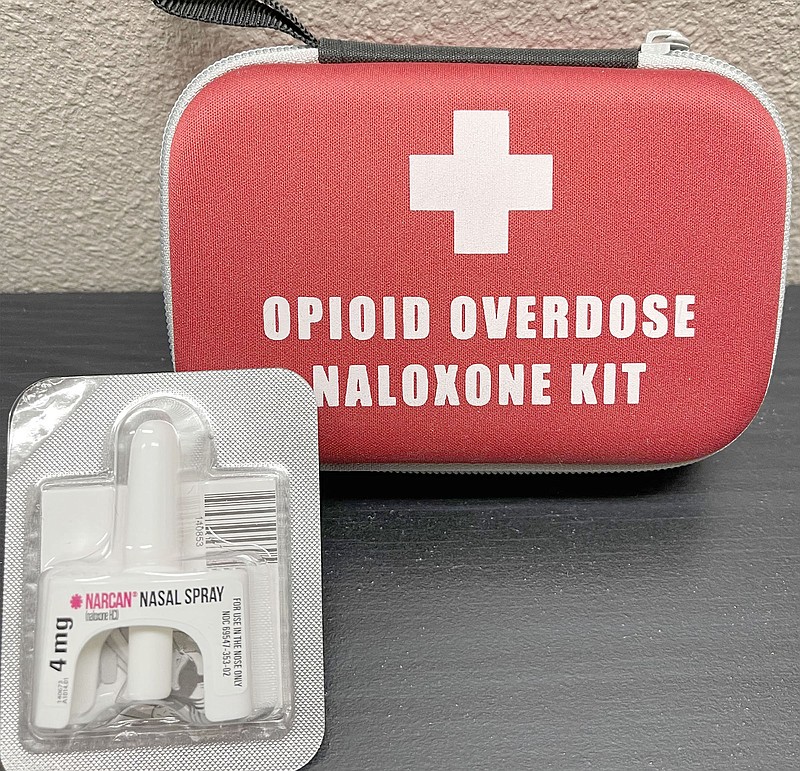BENTONVILLE -- Two police officers arrived at different scenes earlier this year. Both suspected the person in front of them was overdosing. The officers used naloxone to save their lives.
Naloxone is a medicine that rapidly reverses an opioid overdose. It's an opioid antagonist, which means it attaches to opioid receptors and reverses and blocks the effects of other opioids, according to the National Institute on Drug Abuse.
Police departments in Northwest Arkansas and across the country use naloxone in response to the ongoing opioid problem.
Nearly 50,000 people in the United States died from opioid-involved overdoses in 2019. The misuse of and addiction to opioids is a serious national crisis that affects public health as well as social and economic welfare, the institute said.
In Arkansas, nearly half of the 444 reported drug overdose deaths involved opioids in 2018, according to the institute.
Pea Ridge police officer Justin Lawson was the first to arrive at a scene March 27. He found a 37-year-old woman unconscious, unresponsive and with abnormal breathing, whose friend had given her medication to alleviate pain, according to a Pea Ridge Police Department news release.
Lawson recognized signs of a drug overdose and administered intranasal naloxone to the woman, the release stated. Naloxone only resuscitates people. They still need to be taken to a hospital for further care, said Lt. Mike Lisenbee, Pea Ridge Department spokesman.
David Fortner, vice president of operations and director of pharmacy for Mercy Hospital Northwest Arkansas in Rogers, said naloxone quickly and effectively reverses the effects of opioids.
"In an opioid overdose situation, Naloxone can and will save lives," Fortner said. Patients prescribed opioids, particularly in high doses or for extended periods of time, should have a prescription for naloxone, he said.
Opioids include heroin, fentanyl, oxycodone, hydrocodone and morphine, according to the institute. Naloxone can be given as a nasal spray or it can be injected into the muscle, under the skin, or into the veins, according to the institute.
Benton County Coroner Daniel Oxford said there have been 42 confirmed overdose deaths in the county between July 19, 2019, and now. The number could be higher because the office is waiting on numerous toxicology reports, he said.
Sebastian County Coroner Kenny Hobbs said seven overdose deaths were reported in 2019, 14 in 2020 and five so far this year.
Lt. Scott Vanatta of the Bella Vista Police Department faced a similar emergency a few days after Lawson. Vanatta was first on the scene with a person overdosing on heroin, said Cassi Lapp, city spokeswoman. Vanatta administered naloxone, Lapp said.
All Bella Vista patrol officers have carried naloxone since 2019, Lapp said. The March 30 call was the first time a Bella Vista officer had administered the drug, she said.
Naloxone is an important tool for officers to have especially with the threat of Fentanyl, said Keith Foster, Rogers Police spokesman. Fentanyl is a powerful synthetic opioid analgesic similar to morphine but is 50 to 100 times more potent. It is a Schedule II prescription drug and is typically used to treat patients with severe pain or to manage pain after surgery, according to the institute.
Adam McInnis, spokesman for the Bentonville Police Department, said officers carry basic first aid kits but not naloxone. McInnis said police have not seen a significant amount of overdose-related incidents in the community.
Overdose calls are also classified as a medical call, which automatically prompts dispatchers to send the Bentonville Fire Department, he said.
"The Bentonville Fire Department has excellent response times and are properly trained to administer a certain level of medical care to patients," he said. Their training includes administering naloxone if needed, he said.
